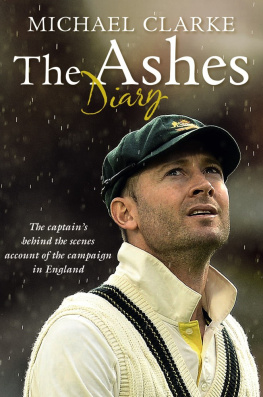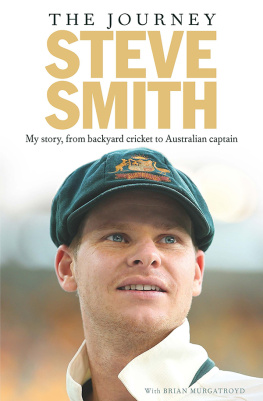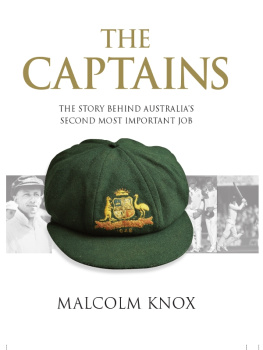About The Ashes Diary
Michael Clarkes fascinating and insightful diary of the 2013 Ashes series in England.
Taming the might of a resurgent English cricket team was never going to be an easy task even before some of the off-field issues that hit Michael and the Australian team, such as the sacking of Mickey Arthur just days prior to the First Test at Trent Bridge.
The young team, filled with more talent than experience, came heartbreakingly closer to their goal than the final Test score of 30 indicates. Michaels account of what was going on behind the scenes and on the field gives us a fresh, informed and intimate view of the tour the highs, the lows and the many controversies that dogged the series.
In his role as Australian captain, Michael Clarke has introduced a very different dynamic into the traditions of captaincy. Open, inclusive and articulate, Clarke has put his own distinctive stamp on the job. Now he puts his stamp on the Captains Diary, giving us his unique perspective, delivered with trademark intelligence and honesty.

Contents
To my wife, family, fans and teammates all of
whom play a special role in my success.
INTRODUCTION
26 May. Home.
Here on my bedroom floor are my possessions for the next four months of my life.
My main suitcase contains casual clothes, toiletries and two green Australian cricket helmets. I have three blue cricket coffins. Two hold my cricket clothing, either whites or yellows, and a third holds all my training gear: shirts, shorts, tracksuits. Another green cricket coffin has my first-class cricket gear bats, gloves, pads and so on and one-day gear, the main items duplicated in gold limited-overs colours. I have four pairs of runners, each for different purposes, and six pairs of spiked cricket boots travelling in shoeboxes. I have a rack of six Spartan cricket bats.
In another small bag I have some comfortable clothes to change into we leave for the flight in our team suits my passport, phone, sunglasses, keys, iPod mini and speaker, watch, personal toiletry items, notepads and reading material. In this bag are also some special items, such as a copy of Zen in the Martial Arts by Joe Hyams, and personal messages Ive been given. Taped to the inside flap of this bag is a piece of paper that I keep as a constant reminder of my guiding principle. It comes from Mike Young, the former Australian fielding coach, and it says:
A professional is ... One who competes against the challenges brought before him by others and is willing to test himself each and every day to be the best he can possibly be and not the best others feel he should be!
Also in that special bag are my baggy green cap and the green and gold pouch that all Australian Test cricketers receive. My pouch is embroidered M.J. Clarke 389, indicating that 388 men have played Test cricket for Australia before me. My blazer pocket is embroidered with the number 43, signifying the number I hold in the line of Australian Test cricket captains since 1877. Im travelling fairly light, but with more than a century of history.
27 May. Emirates flight to Dubai and London.
On the flight, I unwind quietly and take the time to think. In the nearly two months since we came back from India, thinking is something Ive been doing a lot of.
The first part of the year definitely didnt go to plan. Id pictured a successful Test tour to India, a season in the Indian Premier League (IPL) with the Pune Warriors, and a good healthy build-up to this moment: my third Ashes tour, my first as Australian captain.
Instead, we lost the Tests in India 40. We had some well-publicised problems with team discipline. My back and right hamstring, which had been hurting for most of the Australian season, finally got the better of me in the last of those matches in India, which was shattering as Id never missed a Test match through injury in my career. And then, as soon as I got home, I was hospitalised with a bout of gastroenteritis. Instead of playing IPL, I was getting over that gastro and driving two hours a day to and from my physio in Beecroft, in Sydneys northern suburbs, from my home in Cronulla, to spend an hour and a half having a machine treating my back, combined with hands-on treatment.
Like I said: plenty of time to think.
I dont accept the way we played in India. Theres a temptation to forget all about it the past is the past and all that but if you lose the way we lost, and dont learn anything, youll never progress. Whats that saying: Those who cannot remember the past are condemned to repeat it ? We are absolutely determined not to repeat that history in England.
For me, the road back starts with rehabilitating my personal fitness. The sessions with my physio, Steve, on his MedX machine I regard as money in the bank. I sit in position in the machine while it stretches me to full flexion and full extension. Every second I spend in there is strengthening me. The machine weighs too much to take around the world with me, so I have to make the most of it when I am home. We started off with daily sessions, gradually winding back to three days a week. The degenerative disc problem in my back has been with me since I was a teenager, and I know that batting and fielding for long periods arent the best thing for it so making my back stronger, when I have the chance, is a matter of life and death for my career.
When I felt strong enough, I went down to Berrima in the Southern Highlands for my annual two-week boot camp with fitness trainer Duncan Kerr, who Ive known since I was 17. We did three sessions a day, starting early and ending late: a full mental and physical challenge. Its extreme. I reckon I get six months worth of fitness in those two weeks more money in the bank. In those hard and lonely hours, Im not always thinking about cricket, but when I am, Im thinking that no one out there, no one , is putting in this kind of preparation, and when I step onto the field at Trent Bridge on 10 July, I will know that no bowler will have encountered a batsman as physically fit as Im going to make myself.
When I started out in Test cricket in 2004, some players didnt take fitness quite this seriously. The Australian team had long moved on from beers and cigarettes at stumps, but there were only a few guys who treated batting as a full physical challenge requiring months of preparation. For me, a love of fitness was kind of in the blood. My sister Leanne used to do triathlons and is an aerobics instructor, and Ive always loved the feeling of being fit. When I walk onto a ground to bat, in peak physical condition, it does wonders for my confidence. When youre fit in your body, your mind stays clearer. Fatigue doesnt play mental tricks on you. Ultimately, its the difference between playing that tired shot when youve been batting for two or three hours, and going on to bat for more than a day. Its the difference between scoring 60 or 80, or a double-hundred.
On those drives to and from Steves, and on the runs in Berrima, my mind kept going back to the tour of India, where it was our batting that killed us. We had the best of the conditions, winning the toss and batting first in each Test match, but were never able to put 500 runs on the board. We batsmen have to take accountability for that. Individually, we all made starts, but we were hardly ever able to convert. At some point, our concentration slipped, and one mistake was fatal. We just didnt have the endurance.
After my boot camp, I started spending three days a week, every Sunday through to Tuesday, at Cricket Australias Centre of Excellence in Brisbane. I began working on my batting again, and had some good chats with the other guys from the team whod been coming to prepare. We all agreed that we needed to find out why we didnt succeed in India, and to correct those shortcomings.
Next page











